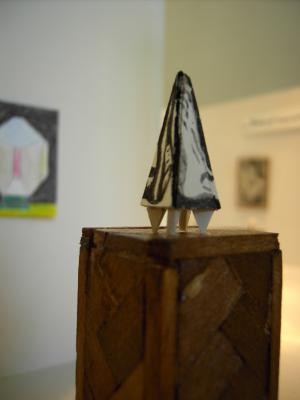Andreas Chwatal & Leonhard Hurzlmeier
10 Jun - 30 Jul 2011
ANDREAS CHWATAL & LEONHARD HURZLMEIER
Abendland
10 June - 30 July, 2011
ANDREAS GRIMM MUNCHEN is pleased to announce the exhibition ‘Abendland,’ a collaboration of two young artists from the Munich Art Academy: Andreas Chwatal (born 1982 in Regensburg, Germany) and Leonhard Hurzlmeier (born 1983 in Starnberg, Germany). The exhibition features installations, drawings as well as paintings.
The imagery of Leonhard Hurzlmeier is one of geometry. Clean lines, triangles, rectangles and trapeze converge and coincide, creating works of playful ornamentation, contrasting the more algid abstraction of someone like Mark Rothko. By approaching the paintings of Hurzlmeier, the viewer realizes, that the supposedly even canvases feature a very detailed structure. The artist accentuates the ‘scars’ of the entire painting process and thereby creating an interesting contrast between the calculated motive and the organic feeling of the paintings. Hurzlmeier paints on already used canvases, whose surfaces he completely repaints, however, he allows the ‘old’ texture to shine through and by doing so, his works become immanent documents of time.
The playful works of Andreas Chwatal reflect in some way the concrete ornamentation of Leonhard Hurzlmeier’s paintings. At first sight, Chwatal’s work appears to be mere something like props, antiques or insights into apartments and bureaus, removed from their original context. In those works graphical and sculptural means are interfused to one installation, trying to showcase the whole of a story in one snippet. As in most of Chwatal’s works, the artist integrates also a textual level: poetic texts, which Chwatal regards as images as well, underlining the fictional character and just seemingly contributing to the decipherment of the presented works. A story is evoked and not unlike a crime story, it pulls the viewer into a vortex. Apparently conflicting elements and memorized images crystallize into a mysterious overall picture.
The combination of works by Chwatal and Hurzlmeier creates an almost fairytale-like but implicitly baroque backdrop. Ornaments are no longer a crime anymore, as Adolf Loss once postulated. In fact they become the necessary art element, a link connecting the two artists. In the tradition of a Gesamtkunstwerk the gallery is turned into an ‘Abendland:’ allusive, full of metaphors and cryptical clues between image, text and sculpture.
Abendland
10 June - 30 July, 2011
ANDREAS GRIMM MUNCHEN is pleased to announce the exhibition ‘Abendland,’ a collaboration of two young artists from the Munich Art Academy: Andreas Chwatal (born 1982 in Regensburg, Germany) and Leonhard Hurzlmeier (born 1983 in Starnberg, Germany). The exhibition features installations, drawings as well as paintings.
The imagery of Leonhard Hurzlmeier is one of geometry. Clean lines, triangles, rectangles and trapeze converge and coincide, creating works of playful ornamentation, contrasting the more algid abstraction of someone like Mark Rothko. By approaching the paintings of Hurzlmeier, the viewer realizes, that the supposedly even canvases feature a very detailed structure. The artist accentuates the ‘scars’ of the entire painting process and thereby creating an interesting contrast between the calculated motive and the organic feeling of the paintings. Hurzlmeier paints on already used canvases, whose surfaces he completely repaints, however, he allows the ‘old’ texture to shine through and by doing so, his works become immanent documents of time.
The playful works of Andreas Chwatal reflect in some way the concrete ornamentation of Leonhard Hurzlmeier’s paintings. At first sight, Chwatal’s work appears to be mere something like props, antiques or insights into apartments and bureaus, removed from their original context. In those works graphical and sculptural means are interfused to one installation, trying to showcase the whole of a story in one snippet. As in most of Chwatal’s works, the artist integrates also a textual level: poetic texts, which Chwatal regards as images as well, underlining the fictional character and just seemingly contributing to the decipherment of the presented works. A story is evoked and not unlike a crime story, it pulls the viewer into a vortex. Apparently conflicting elements and memorized images crystallize into a mysterious overall picture.
The combination of works by Chwatal and Hurzlmeier creates an almost fairytale-like but implicitly baroque backdrop. Ornaments are no longer a crime anymore, as Adolf Loss once postulated. In fact they become the necessary art element, a link connecting the two artists. In the tradition of a Gesamtkunstwerk the gallery is turned into an ‘Abendland:’ allusive, full of metaphors and cryptical clues between image, text and sculpture.

